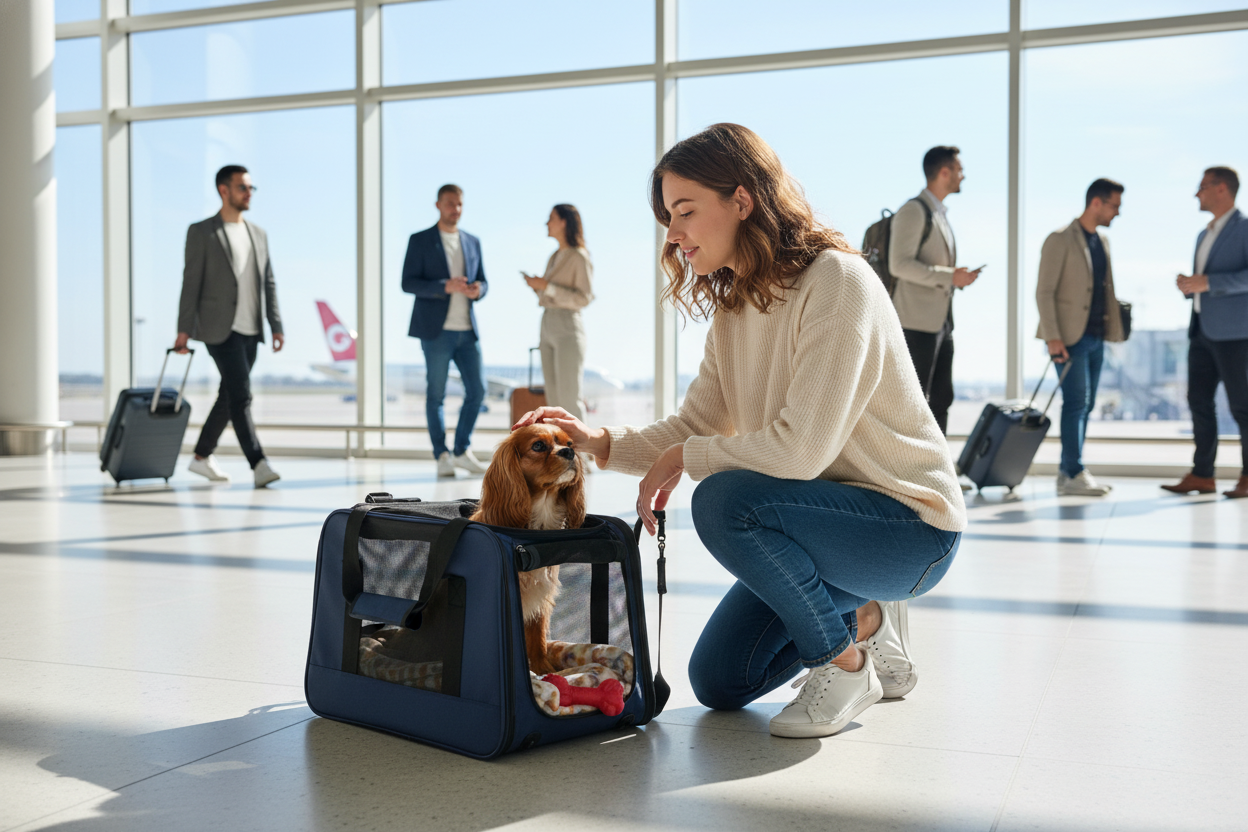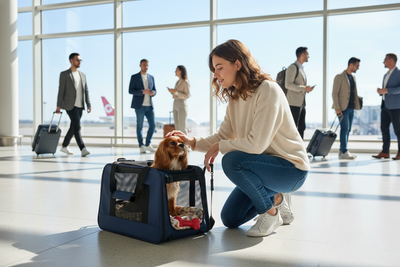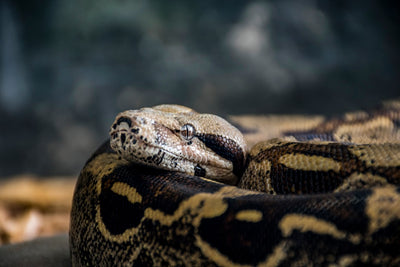Taking to the Skies with Your Pet: Real Travel Triumphs
The announcement of your upcoming flight creates a mix of excitement and anxiety. But when you glance over at your furry family member, that anxiety often multiplies. How will they handle the journey? Will they be comfortable? Safe? Many pet parents have faced this dilemma, wondering if air travel with their beloved companions is worth the stress.
The good news? With the right pet travel carrier airline approved by major airlines, your journey can transform from a potential nightmare into a smooth adventure. We've collected real stories from pet owners who successfully navigated the friendly skies with their companions, proving that with proper preparation and the right equipment, air travel with pets can be a positive experience for everyone involved.
From nervous first-timers to seasoned pet travelers, these stories offer practical insights, unexpected solutions, and the reassurance that you're not alone in wanting the best travel experience for your four-legged family member.
Preparation Success Stories: Setting the Stage for Smooth Travels
Ask any successful pet traveler their secret, and most will tell you the same thing: preparation begins weeks before your departure date. The carrier that will transport your precious cargo isn't just a purchase; it's an introduction to a new, temporary space that your pet needs to feel secure in.
"I was terrified about flying with Bella, my Cavalier King Charles Spaniel," shares Megan from Colorado. "Three weeks before our cross-country move, I placed her airline-approved carrier in our living room with her favorite blanket inside. I started with the carrier door open, treating it like a new bed rather than a cage."
Megan's approach paid off. By gradually increasing the time Bella spent in the closed carrier, including short car rides to simulate movement, her pet was comfortable and calm on flight day. "She actually fell asleep during takeoff, which I never expected!"
Pre-Flight Carrier Training That Worked
Successful pet travelers consistently mention carrier familiarity as their top preparation strategy. Here's how they made it work:
Michael and his Maine Coon cat, Zeus, had a six-hour flight ahead of them. "Cats are particularly sensitive to new environments," Michael explains. "I made Zeus's carrier a positive space by feeding him treats exclusively inside it for two weeks before our flight. I also sprayed a calming pheromone product inside the carrier each day."
Michael's technique helped Zeus associate the carrier with positive experiences. "During the flight, he remained calm even during turbulence. The flight attendant commented that she didn't even realize we had a cat onboard until we were deplaning."
For larger dogs flying in the cargo hold, preparation becomes even more critical. Samantha traveled with her Golden Retriever, Cooper, from Seattle to Miami. "We purchased our airline-approved cargo carrier a month in advance. We set it up in our bedroom where Cooper sleeps, removed the door initially, and gradually worked up to having him comfortable with door-closed time."
Samantha also incorporated sounds into her training: "I played recordings of airplane noises during Cooper's meals in the carrier. By flight day, the sounds were so normalized that the actual plane didn't faze him."
These success stories highlight a crucial pattern: pets who view their carriers as safe spaces rather than confinement tools handle air travel significantly better. The key is positive association and gradual acclimation.
Choosing the Perfect Airline-Approved Carrier: Features That Made the Difference
When Lisa needed to fly with her French Bulldog, Max, she knew carrier selection would be crucial for her brachycephalic breed. "French Bulldogs can have breathing challenges, so I needed a carrier with exceptional ventilation," she explains. "I researched extensively and found a soft-sided carrier with mesh panels on three sides, providing maximum airflow while still fitting under the seat."
Lisa's careful selection paid off. "Max remained comfortable throughout our four-hour flight. The carrier's expandable side gave him extra room during our layover, and the multiple entry points made security screening less stressful for both of us."
Features That Made Travel Day Seamless
Pet travelers consistently mention certain carrier features that proved invaluable during their journeys:
Proper Ventilation Systems
James traveled with his cat, Whiskers, from Dallas to Boston. "The summer heat made me nervous about adequate airflow," he recalls. "I chose a carrier with ventilation on all four sides, not just the typical front and top. During a tarmac delay in 90-degree weather, that extra ventilation kept Whiskers comfortable while other passengers were sweating."
Secure Closures That Still Allow Quick Access
"My escape artist Beagle taught me the importance of secure zippers," laughs Rebecca from Oregon. "After a near-escape during a previous trip, I invested in a carrier with lockable zipper pulls. During our flight, the carrier shifted during turbulence, but the secure closures kept everything intact. The side access panel also allowed me to comfort him without opening the main compartment."
Proper Size and Weight Compliance
Airlines have strict size requirements for in-cabin carriers, typically requiring them to fit under the seat in front of you. Dimensions vary by airline and aircraft type, making research essential.
"I almost made a costly mistake," admits Daniel, who flew with his Yorkie. "I initially purchased a carrier based on another pet owner's recommendation, only to discover it exceeded United's size restrictions by two inches. I had to rush-order a compliant carrier a week before departure."
Daniel's last-minute carrier swap taught him a valuable lesson: "Always check your specific airline's requirements rather than relying on general advice. I now have a document with the exact carrier dimensions allowed on the airlines we typically fly."
Comfort Features That Reduced Anxiety
Emma's anxious Siamese cat, Luna, had never traveled before their necessary relocation. "I chose a carrier with a removable, machine-washable plush pad and included a piece of my worn clothing for familiar scent," Emma explains. "The carrier also had a privacy flap I could lower when Luna seemed overwhelmed by the airport activity."
These thoughtful additions helped Luna remain calm throughout their journey. "The flight attendant commented that she'd never seen such a relaxed cat on a plane. The comfort features weren't just luxuries; they were essential for Luna's emotional well-being."
Durability That Withstood Travel Challenges
For pets traveling in cargo, carrier sturdiness becomes even more critical. When Marcus flew his Labrador from Chicago to San Francisco, he invested in a high-quality hard-sided carrier. "The extra money spent on reinforced corners and metal bolts instead of plastic ones proved worthwhile when I saw how roughly some luggage was being handled," he notes. "My dog arrived safely without any damage to his carrier."
These real experiences demonstrate that successful air travel often hinges on selecting the right carrier with features that address your specific pet's needs and the challenges of your particular journey.
Unexpected Challenges and Solutions: Real-World Problem Solving
Even with perfect preparation, air travel can present unexpected challenges. What separates successful pet travel stories from nightmares is often how owners handle these surprises.
When Teresa's flight with her Shih Tzu was delayed for three hours, she faced a dilemma. "We had already gone through security, and Mochi needed a bathroom break," she recalls. "I had packed a collapsible water bowl and pee pads in my carry-on, which saved us. I was able to offer water and create a small, private bathroom space for him in a family restroom."
Teresa's foresight highlights the importance of a well-stocked pet travel kit. "Other delayed passengers with pets were panicking, but we managed comfortably because I had packed for contingencies."
How Pet Parents Handled In-Flight Issues
The Nervous Pet
David's normally calm Pomeranian, Coco, became anxious during takeoff. "The engine noise clearly frightened her, despite our preparation," he explains. "I had consulted with our vet beforehand and had a natural calming supplement approved for air travel. Within twenty minutes, Coco settled down."
David emphasizes the importance of vet consultation before travel: "Having solutions pre-approved by our veterinarian gave me confidence to handle Coco's anxiety without second-guessing myself during a stressful moment."
The Overheated Pet
When Sarah's flight to Phoenix was stuck on the tarmac for an hour before takeoff, her cat began showing signs of overheating. "I had packed a small battery-operated fan that attached to the carrier mesh," she shares. "It made all the difference while we waited for the air conditioning to fully kick in."
Sarah also used a trick recommended by her veterinarian: "I brought a ziplock bag that I had the flight attendant fill with ice. Wrapped in a thin towel, it provided cooling relief when placed against the carrier's exterior."
The Refused Carrier
Perhaps the most dreaded scenario is having your carrier rejected at check-in despite believing it met requirements. This happened to Carlos with his Miniature Schnauzer.
"The airline staff claimed my soft-sided carrier was an inch too tall, even though I had measured carefully," he recounts. "Rather than argue, I had a backup plan: the carrier had compression straps designed specifically for this situation. I adjusted them to reduce the height slightly, and we were approved."
Carlos's experience underscores the value of carriers designed with airline compliance in mind. "Those compression features weren't an accident; the manufacturer clearly understood the real-world challenges of pet travel."
The Unexpected Layover
When weather diverted Jennifer's flight to an unplanned overnight stay, she faced finding pet-friendly accommodation on short notice. "I had photographed all of Baxter's vaccination records and registered him as my travel companion with the airline," she explains. "This documentation made it much easier to quickly find a hotel that would accept him."
Jennifer's preparation extended beyond the flight itself: "I also packed an extra day's worth of his food in my carry-on, which proved essential during our unexpected extended travel time."
These real-life solutions demonstrate that successful pet travel often depends on anticipating potential problems and having specific plans to address them. The common thread among these stories is preparation that extends beyond the basics.
Navigating Airline Policies: What Actually Worked
Understanding and navigating airline pet policies can feel like deciphering a foreign language. Successful pet travelers share what actually worked when dealing with airline requirements.
"Delta's website stated one policy, but when I called directly, I received slightly different information," explains Tyler, who traveled with his Miniature Pinscher. "I asked the representative to email me the confirmation of our conversation, which proved invaluable when a check-in agent questioned my carrier's compliance."
Tyler's experience highlights a crucial strategy: get written confirmation whenever possible. "Having that email on my phone prevented what could have been a travel disaster."
Alicia, traveling internationally with her cat, took documentation a step further. "I created a 'pet passport' folder with every possible document: health certificates, vaccination records, airline pet reservation confirmations, and even the specific carrier measurements with photos of my cat in the carrier."
This thorough approach paid dividends during her complex journey. "At every checkpoint, officials were impressed by my organization. It streamlined what could have been lengthy verification processes."
For pets traveling in cargo, Rachel discovered the value of direct communication with the airline's cargo department. "Speaking directly with cargo handlers rather than just general customer service representatives gave me specific information about how and when to drop off my Labrador, Bruno."
Rachel's proactive approach resulted in meeting a cargo handler who gave her real-time updates. "He texted me when Bruno was loaded and again when he was safely unloaded. That peace of mind was priceless."
Arrival Success: Helping Pets Adjust After the Journey
The journey doesn't end when the plane lands. Successful pet travelers share how they helped their companions adjust after reaching their destination.
"After our five-hour flight, I resisted the urge to immediately release Bella from her carrier in the busy baggage claim area," explains Ryan about traveling with his Border Collie. "Instead, I took her to a quiet corner of the pet relief area, opened the carrier, and let her decide when to come out."
Ryan's patience paid off. "She took about ten minutes to venture out, but then recovered quickly without the additional stress of a chaotic airport environment."
For longer journeys, especially those crossing time zones, gradual reintroduction to normal routines proved beneficial. When Heather flew with her Ragdoll cat from New York to London, she created a transition plan.
"I set up a small, quiet room at our new home with familiar items from our previous house," she describes. "For the first 24 hours, I kept Snowball's world small and predictable, gradually expanding his territory as he showed comfort signals."
Heather also maintained feeding schedules based on their origin time zone, slowly adjusting by 30 minutes each day. "This methodical approach prevented digestive issues and helped with his overall adjustment."
These arrival strategies demonstrate that successful pet travel extends beyond the flight itself, encompassing the entire journey from door to door.
Your Journey Awaits: Turning Travel Anxiety into Adventure
These real-life experiences demonstrate that successful air travel with pets hinges on selecting the right airline-approved carrier and preparing thoroughly. From the careful selection of ventilated, secure, and comfortable carriers to the thoughtful preparation that helps pets view these carriers as safe spaces rather than confinement tools, each success story shares common elements of planning and attention to detail.
What stands out across these narratives is how proper preparation transformed what could have been stressful experiences into manageable, and sometimes even enjoyable, journeys. The pet parents who shared their stories weren't just lucky; they researched, planned, and equipped themselves with both the right physical tools and knowledge to navigate challenges.
As you consider your own upcoming travels with your furry, feathery, or scaly companion, remember that your pet takes cues from you. Your confidence, built on thorough preparation and the right equipment, directly influences their travel experience. By applying these tested strategies and investing in a quality airline-approved carrier that meets your specific pet's needs, you can approach your next flight with confidence rather than anxiety.
Air travel with pets doesn't have to be a source of dread. With the right approach, it can become another adventure you share with your beloved companion, creating stories of your own successful journeys through the friendly skies.






